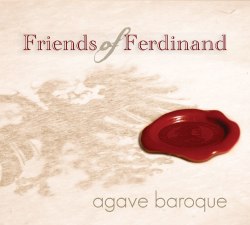|

|
Friends of Ferdinand - Music from the court of the Holy Roman Emperor
Antonio BERTALI (1605-1669)
Chiacona for violin and bc [5:24]
Sonata à 2 for violin, viola da gamba and bc [8:14]
Marco Antonio FERRO (1600-1662)
Sonata for violin and bc op. 1,10 [5:03]
Johann Heinrich SCHMELZER (c1620-1680)
Sonata variata à 2 for violin and bc [6:47]
Heinrich Ignaz Franz VON BIBER (1644-1704)
Sonata for violin and bc in E (C 108) [12:41]
Johann Heinrich SCHMELZER or Antonio BERTALI
Sonata X for violin and bc (Prothimia Suavissima, I) [4:21]
Johann Heinrich SCHMELZER
Lamento sopra la morte Ferdinandi III à 3 [7:34]
Giovanni Battista GRANATA (c1620-1687)
Sonata for guitar, violin and bc [9:20]
Agave Baroque (Aaron Westman (violin), Shirley Hunt (viola da gamba), Kevin Cooper (guitar), JungHae Kim (harpsichord))
rec. OAB Auditorium, Fresno City College, Fresno, CA, USA, no date given. DDD
VGO RECORDINGS VG1021 [59:26]
For many centuries the Habsburg dynasty was one of the most powerful in Europe. Until the end of the 18th century the emperors of the Holy Roman Empire played a major role, not only in the political scene, but in musical life as well. They attracted some of the best performers and composers of their time. The court in Vienna was a centre of music-making at the highest level. Various composers who worked there are still quite famous. Some of the emperors were not only music-lovers; they were also composers.
It is not difficult to assemble a programme of music written for or played at the court in Vienna. Discs addressing the music scene at Vienna’s imperial court are not hard to find. All of this makes it the more disappointing that so many discs include the same pieces. No change here: the Chiacona by Bertali and Schmelzer's Lamento are among the best-known pieces from the repertoire. Fortunately we also get to hear some little-known compositions, especially the sonatas by Ferro and Granata.
All the pieces played here are of fine quality. From that angle this disc deserves a positive reception. However, it has several shortcomings. First of all, the liner-notes are very concise: they hardly provide any information about the composers and the music. That is especially regrettable as the above-mentioned composers Ferro and Granata are largely unknown quantities. Secondly, the subtitle of this disc suggests that the music recorded here was written for or at least played at the court of the Habsburg emperors. That is not the case, though: Biber had no formal ties to the Viennese court. He once played before Leopold I, at the imperial summer seat in Laxemburg, but it is impossible to say whether he played a piece like the Sonata in E which is part of the archive of Kremsier where Biber started his career in the service of Bishop Karl Liechtenstein-Castelcorno. Granata certainly had no ties with the Habsburg dynasty: he was born in Turin and moved to Bologna, where he studied the guitar with Francesco Corbetta. There he remained for the rest of his life.
I am also slightly disappointed by the performances. There is too much restraint in the interpretation of the Biber, Schmelzer and Bertali pieces. The Granata comes off best, and here I enjoyed the flair largely missing in most of the other items. In the Chiacona by Bertali the performers try to do too much, especially in the realisation of the bass. This distracts from the returning bass pattern which is one of the main features of the piece. Here the guitar has too much presence as in several other pieces, for instance Schmelzer's Lamento. That is not only regrettable from a musical point of view, it is also questionable from a historical angle. The article on the guitar in New Grove gives us no reason at all to assume that this instrument played a significant role at the imperial court in Vienna. In the Chiacona the artists have not been able to resist the temptation to use the guitar as a percussion instrument.
In the Chiacona the violin is played rather well. I am less enthusiastic about the Sonata in E by Biber. It is a technically highly demanding piece, and it seems that Aaron Westman hasn't completely mastered it yet. He is certainly no match for Anton Steck (Sonatas from the Kremsier Archive; CPO, 2005). The Sonata X by Schmelzer or Bertali is one of the most remarkable pieces here. It is from a collection of compositions whose author is indicated with the initials "J.S.A.B.". Research has led to the conclusion that these refer to Johann (Heinrich) Schmelzer and Antonio Bertali. Apparently it is not known who composed what. This sonata includes a number of chromatic passages and is a good example of the stylus phantasticus which emerged in Italy in the early decades of the 17th century.
On balance, this disc seems to best suited to those who have a special interest in this area. For the general lover of early music it leaves too much to be desired. This music needs to be played with more theatrical flair than is the case here.
Johan van Veen
http://www.musica-dei-donum.org
https://twitter.com/johanvanveen
 |
 |
|
